Zoltán Kiss- Area Sales Manager - East Europe - Endrich GmbH.
Practical usage of Panasonic GRIDEYE sensor v2.0 – Part 1.
11 April 2017

Summary :
Earlier we compared several movement and presence detection technologies and introduced Panasonic’s GridEye 64 pixels intelligent thermopile array sensor as one of the best options to detect stationary objects. It can be used to detect, count or follow movement of humans, also capable of supporting gesture control. The new generation of tis sensor has been launched, and we would like to draw readers’ attention to this unique technology again.
Engineers of general lighting area are focused on designing compact, intelligent and energy efficient systems, which could be realized by adding the feature of automatic switching off, when no human presence is detected. Today these intelligent sensors are mainly based on passive infrared (PIR) technology, that is perfect for detecting human motion with huge amplitude on a large detection area, however it is not effective with tiny movements, and it is also unable to distinguish between approaching and leaving of objects. Doppler radar sensors with CW and FSK modulation are capable to fulfill many of the tasks PIR sensors cannot solve but based on their working principle they require movement to detect. Although tiny movements can usually be observed there is a problem still with stationary objects, for which only FMCW modulation gives a right answer. As direction sensing is limited to approaching and leaving, special tasks, like counting people entering and leaving a room is not easily possible. People sitting in an office, making no remarkable movement will be considered not present with these devices. Panasonic’s GridEye sensor is based on a thermopile matrix, and acts like a low resolution thermo camera, therefore perfectly suits for presence detection. Evaluating the thermo image by microprocessor-based host system more complex observations can be done. Integrating into an intelligent lighting or building automation system, the problems encountered with PIR or radar sensors can be eliminated. Table 1 shows a comparison on above mentioned technologies.
GRIDEYE thermosensor
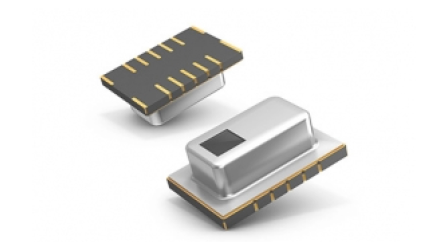
The new Grid-Eye infrared array sensor device of Panasonic is a thermopile-type infrared sensor, which detects quantity of infrared ray. These high precision sensors, based on advanced MEMS technology, have absolute temperature detection, achieved on a twodimensional area of 8X8 “pixels”, having digital I2C output, and a miniature SMD package. The Grid-EYE device is capable to detect temperature and temperature gradients contactless over the entire specified area with viewing angle of 60o due to the built-in silicon lens, providing thermal image of the observed environment. It’s easily possible to differentiate between multiply objects, to identify direction of movement by evaluating the simple thermo image, while there are no issues of violating privacy rights. Cost effective, but highly precise applications can be realized by connecting this sensor to the microcontroller of the host system using the digital I2C communication interface and read out the output at speeds of 1 -1 0 fps. The output interrupt function can be used for initiating immediate actions based on detection criteria. The 64 pixels yield accurate temperature measurement provides a possibility for a body shapebased detection.
Comparison of motion detection technologies:
| Moving object | Stationary object | Movement direction | Temperature measurement | Speed measurement | Thermal image | ||
|---|---|---|---|---|---|---|---|
| PIR | YES | X | X | X | X | X | |
| Radar | YES | Limited(only FMCW) | Limited (approaching-leaving only) | X | YES | X | |
| Discrete thermopile | YES | YES | X | YES | X | X | |
| Grid-EYE | YES | YES | YES | YES | Calculation | Yes |
The working principle of the GRID-EYE is based on thermoelectric effect (Seebeck effect), it consists of thermopiles, a serially-interconnected array of thermocouples. This sensor absorbs the infrared radiation penetrating through the silicon lens, and the standalone pixels transform the thermal energy into proportional electric signal. The detected signals of the 64 pixels (in 8x8 organization) will be amplified, analog/digital converted, and after comparison with a reference ambient temperature value provided by e built-in thermistor, are read by the microprocessor through I2C interface for calculation ofthe thermal image.
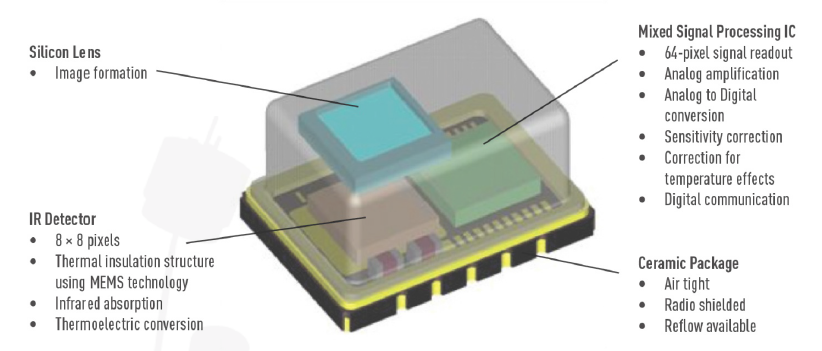
The very first generation of GridEye provided maximum 2.5oC accuracy on the temperature range of 0-80oC, even in case of the low-gain version, accuracy was 3oC over -20-1 00oC, from 5m detection range and with 0.5oC resolution. The new generation of the sensor features much higher accuracy (±2°C), and the NETD (Noise Equivalent Temperature Difference), describing the signal/noise ratio, is 0.1 6°C at sampling rate of 1 0 Hz, and 0.05°C at 1 Hz. The detection range has increased from 5m to 7m, preserving downward compatibility with the previous generation, so no need to redesign circuitry when upgrading to the new generation. Panasonic GridEye GEN2 combines the contactless thermal measurement with the MEMS (Micro Electro Mechanical System) technology, incorporating an enhanced application specific digital IC (asic) and providing an I2C interface for the application. The 11 .6mm x 8mm x 4.3mm tiny housing, which is 70% smaller than competitors’ devices, contains a silicon lens, which is a standalone design with its 0.3mm height.
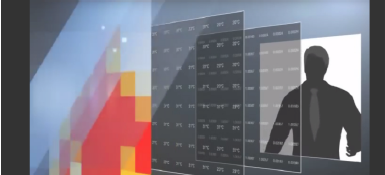
As shown on figure 3, the detection of the human boy is done via contactless thermal measurement. The colored pixels represent the temperature gradient according to the thermal distribution of the heat sources in the divided space in front of the sensor, drawing the thermal map of the area. The date could be read out through the I²C interface pixel by pixel and are evaluated by the application’s microcontroller. Increasing the detection distance, the image of the objects starts to shrink as shown on figure 4, with a well-chosen distance it becomes possible to follow movement or count the number of people present in the observed area.
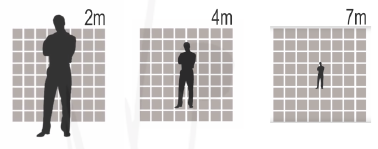
No matter if the object radiating heat is stationary or is in movement, the thermal map can be used for detection of presence and movement. From a higher distance, multiple objects can be differentiated, and the movement speed or direction can be calculated based on the changes of the thermal image.
When using the sensor for close sensing, the hotspot of the body can be detected (fig.5):

This can be used for gesture control, such as switching on driver assisting functions such as wiper control in the cockpit of the passenger vehicle.
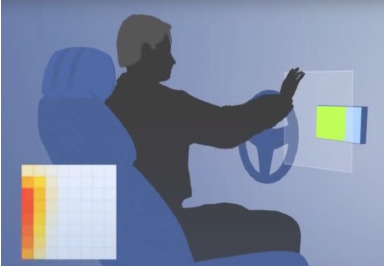
Application area:
Security
- Occupation detection
- People counting, multiple person detection
Household
- Cooking stoves, microwave ovens
- Air conditioners
- Heating systems
Medical
- Patient monitoring
- Movement detection
- Thermal imaging
- Position detection
General Lighting
- Energy saving
- Presence detection without movement
Industrial temperature measurement
- Process control
- Contactless temperature measurement
In order to support fast development of sensor systems and help short time to market, Panasonic provides an evaluation board for the Grid–Eye sensor. This tiny Arduino shield PCB contains USB communication interface, the sensor, ATMEL microprocessor and a low power PAN1 740 Bluetooth smart module as well. Using this kit enables rapid prototyp development and by combining the newest IR sensor with Bluetooth technology, engineers can quickly realize their wireless sensor IoT applications. The available PC software and the smart phone Apps further helps the developers.

This eval board is designed as an Arduino shield, and can be directly attached to a DUE board for fast prototyping. It is user’s choice whether the 64 pixels thermal data and the data of the NTC - providing an ambient temperature reference - are read out by serial (USB) connection for a PC, through the I2C interface of the Arduino board or via the Bluetooth Smart connection for an App made for iOS/Android smart phone or tablet. Panasonic provides visualization software for PC platform as well as App for iOS smartphone using Bluetooth Smart connection for data transfer.
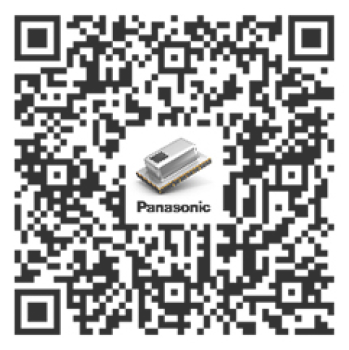
This can be downloaded by using the QR code.
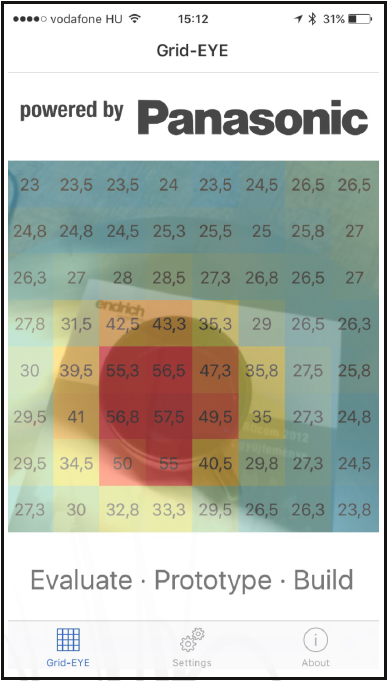
With this APP it is possible to convert the iPhone or iPad device to a low resolution (64 pixel) thermal camera, based on displaying either the momentary direct temperature distribution, or the average heat gradient provided by 1 0 Hz sampling over longer time. The program is able to add the heat distribution image on top of the camera picture for visualizing the detected area.
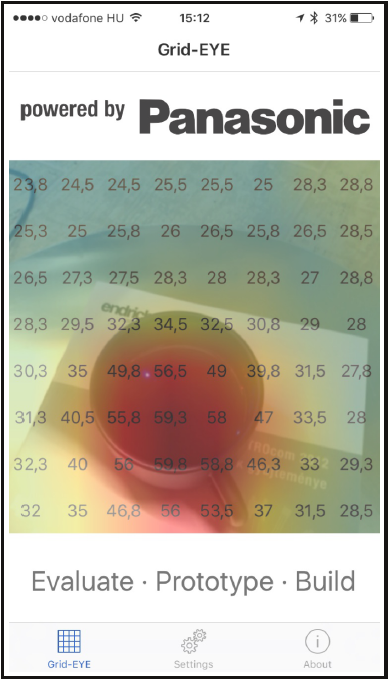
In the next article we are going to show how to use the GridEye Gen2 evaluation kit in Arduino as well as in PC environment.
| Share on Facebook | Share on LinkedIn |
References
This article has been published on the following locations:
| # | Media | Link |
|---|---|---|
| 1 | Elektronet 2017/3 | Elektronet : elektronikai informatikai szakfolyóirat, 2017. (26. évf.) 3. sz. 18-20. old. |
| 2 | TechStory M2M | A Panasonic GridEye Gen2 szenzor használata |
| 3 | Hungarian version | A Panasonic GRIDEYE szenzor 2. generáció használata – 1. rész |


